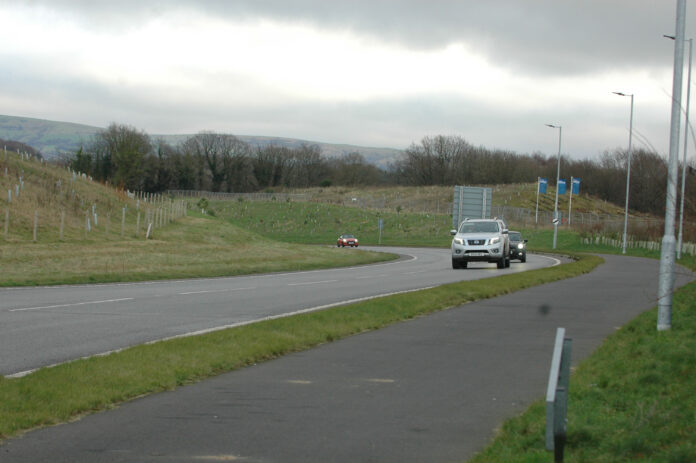The new £90m Congleton link road has apparently failed in its bid to relieve congestion in the town centre, figures obtained by the “Chronicle” suggest – despite promises it would reduce traffic and air pollution in the town.
While the link road was built to serve other functions too – enclosing land for more housing and industry, and providing better links for Back Lane industries – the reduction of vehicles was also a major selling point.
At the public inquiry into the link road at Congleton Town Hall, the QC (as he was then) representing Cheshire East Council said there was “a compelling and pressing need for the scheme”, and argued the council’s case that the road was needed to alleviate the congestion that plagued the town during peak travel times.
He said: “Key junctions within the town are saturated and cannot accept more traffic without generating further delays.”
When plans for the road were announced Coun David Brown, then Cheshire East Cabinet member for highways and infrastructure, said: “The new road will … help to ease traffic congestion in Congleton.”
Another portfolio holder, no longer a councillor, said: “The link road will relieve traffic. The three air quality management areas in Congleton are Rood Hill, West Heath and Lower Heath and the link road will relieve the air quality issues around those areas.”
Cheshire East’s website said at the time: “The link road is aimed to reduce town centre traffic congestion, cut pollution and improve air quality, benefiting people’s health and the environment.”
Even when the link road picked up two awards in 2022, Coun Craig Browne, chair of the authority’s Highways and Transport Committee, said: “This project … has helped reduce congestion and benefited air quality in Congleton town centre.”
Locals driving through Congleton will be aware that the link road is often very quiet – so quiet it is used as a racetrack at night – while West Road and Rood Hill are still very busy, although the link road does seem to take traffic out of the morning rush.
Third
The new road itself is being used by around 10,000 vehicles per week-day – around 65,000 a week in total – which is only a third of the traffic recorded on West Road. A Government traffic county gave a figure as low as 6,000 cars a day for one stretch of the road.
The “Chronicle” asked Cheshire East Council for data on usage of the Wolstenholme Elmy Way and on West Road before and after the link road opened.
The council sent data for West Road after the link road opened – although pre-link road traffic survey results can be found on the internet – as well as data for Clayton Bypass in 2012.
The figures for the link road show that 9,077 cars a day were measured on the stretch between Back Lane and Somerford, 11,437 a day on the section before Viking Way (before the hidden roundabout to Tesco) and 10,237 on the long stretch up to Macclesfield Road, which the “Chronicle” – as it is unlikely that all 10,000 cars turn off at any one point and 10,000 more rejoin – has taken as a general figure for overall usage, although a fair few cars do use the Viking Way link.
On the other hand, West Road was measured as having 28,692 cars as a weekday average a full year after the link road opened, measured at a point near Kwik Fit.
Cheshire East did not send us any figures for before the link road at the same spot but the UK Road Traffic Statistics website, which contains all the published traffic census data for the years 2000 to 2017, shows that in 2017, the surrounding roads fed into and received from West Road similar traffic levels to today: the A34 near Fol Hollow was at 11,271 vehicles a day, the A534 Sandbach Road, near the shopping centre, 10,267 vehicles and the A54 between Black Firs Lane and the A34 6,855 vehicles a day, almost identical to today’s levels if all those cars joined West Road, 28,393 vehicles in 2017 versus 28,692 today on West Road.
UK Road Traffic Statistics also show that on the A34 on Clayton Bypass after Rood Hill lights, 22,099 vehicles a day were recorded in 2017, which was consistent for the previous decade (21,425 in 2007) while on the stretch before Rood Hill lights, 21,692 vehicles were recorded per day in 2017, again consistent over the previous decade.
‘Influence’
The belief that the link road would ease congestion in the town centre was possibly erroneous, too, the “Chronicle” discovered. Hiding in plain site on the original planning application was a Highways England letter, which said in 2015 that while it was anticipated that the new link road would have “some influence” over the route choices made by motorists travelling to and from Manchester, it would not affect traffic levels.
The agency wrote: “It is not felt that this would lead to an appreciable alteration to the distribution of traffic on strategic and connecting main local highway routes across the area.
“The more important consideration for Highways England is the uplift in traffic flows through junction 17 of the M6 arising from various housing development sites.”
The link road was not just marketed as a way to alleviate traffic through town, although its aims were said to be relieving existing town centre traffic congestion and HGVs, removing traffic from less desirable roads, allowing town centre regeneration – due to lower traffic volumes – and reducing traffic-related pollutants.
Its other objectives included:
• supporting the economic, physical and social regeneration of Congleton by creating and securing jobs – new units have appeared on Viking Way, creating jobs, with more on the way; and
• opening up new development sites and improve access to Radnor Park Industrial Estate and Congleton Business Park.
Cheshire East was asked to comment about the high figures for traffic on West Road, why it had told people the road would ease congestion when the Highways Agency said it would not (or to explain what else the agency meant) and what plans it had to reduce traffic congestion in Congleton, but it did not respond.
Town councillor Mark Edwardson said: “The link road is a typical Tory fudge. It was sold to us as a means to divert passing traffic away from Congleton to reduce vehicle numbers and pollution in the town. The figures show that’s not happened.
“As the road was approved by the then Michael Jones-led Conservative, Cheshire East Council I’m not surprised to learn its real purpose was to facilitate the expansion of executive housing in Congleton’s shrinking green space.
“The road is a mish-mash of cheap compromises. Roundabouts hidden in dark dips and atop blind summits suggest the road was a hasty lash up to give Mr Jones’ administration a political win.
“But at what cost? The heaps of damaged vehicles and street sign scrap, the schizophrenic speed limits and the retrofitted lamp standards are testament to the fact the road has already cost much more than £90 million and wasn’t fit for purpose.”





